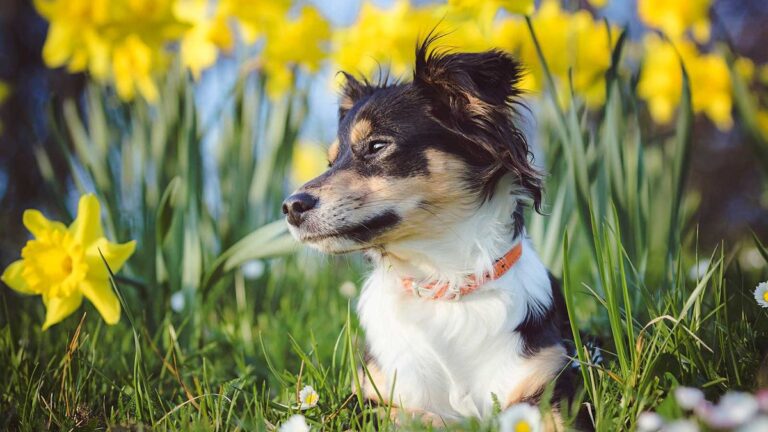Q: Last fall, I planted a lot of spring bulbs, including daffodils and tulips, in borders and pots. I'm looking forward to seeing it bloom, but I recently heard that it's poisonous to pets. I'm a little worried because I have a dog, what precautions do I need to take?
answer: It's no surprise that spring bulbs, with their stunning colors and promise of warmer days ahead, are loved by many, myself included. However, although the bulbs are very pretty, they are poisonous to dogs and cats. This means whether you're planting bulbs in your backyard or forcing them indoors for early display, you need to take steps to keep your pets safe.

If you have pets, be careful not to plant bulbs in your backyard
(Image credit: Anita Kot / Moment / Getty Images)
Dangers of spring bulbs
All spring bulbs can pose a health risk to your four-legged friends. Commonly grown examples include crocuses, daffodils, tulips, bluebells, hyacinths, irises, and snowdrops.
According to Dr. Ray Spragley of Zen Dog Veterinary Care, all parts of the plant contain toxins, but they are concentrated in the bulb. Dr. Sabrina Kong, Senior Veterinary Contributor at WeLoveDoodles, says, “Pets may dig up these bulbs and nibble on them, either because they are naturally curious or because they are simply bored.” I am. The consequences can be serious.
“Spring bulbs can cause gastrointestinal discomfort, drooling, vomiting, diarrhea and mouth ulcers in pets,” Ray warns. “Daffodil is particularly toxic as it can cause central nervous system depression, hypotension and seizures,” he added.
In severe cases, poisoning by spring bulbs can cause respiratory and heart problems, and even death. “If you think your pet has eaten something poisonous, take them to the vet right away,” says Sabrina. “Fast action makes a big difference.”
Top tip: Lilies are extremely poisonous, especially to cats, Sabrina warns. “Even a small amount can cause kidney failure.”

Dr. Ray Spragley is the founder of Zen Dog Veterinary Care, a house call veterinary practice serving pets in both New York City and Westchester.

Dr. Sabrina Kong graduated from the Royal Veterinary College in the United Kingdom in 2016 and has been working in a small animal clinic in Northern California ever since. She also became a certified canine rehabilitation practitioner through a program at the University of Tennessee.

Daffodils can cause serious side effects if ingested by pets
(Image credit: Alexandra Robins / Moment / Getty Images)
Keep your pet safe
“It's important to be proactive to ensure your pet's safety,” says Ferry Morse gardening expert Rebecca Sears. She advises installing fencing, such as a dog fence, to keep pets away from areas where spring bulbs are being planted.
“To create a truly safe environment for your pet, consider planting more pet-friendly plants rather than bulbs,” adds Rebecca. For example, camellias, nasturtiums, rosemary, snapdragons, and roses are considered non-toxic to dogs and cats, and all are equally beautiful (although some bloom a little later).
Bulbs planted indoors, such as hyacinths and amaryllis, should also be kept out of reach of animals. Indoor cyclamen is also dangerous if ingested. Don't forget about the light bulbs you have in your backyard storage area. Ray emphasizes that light bulbs should also be kept safely away from pets.

As CMO and resident green thumb for the Green Garden family of brands, Rebecca Sears not only nurtures the company's heritage, but also develops new products and solutions that help gardeners of all skill levels fuel their passions and become more successful in their gardens. do my best. Rebecca has gardened from coast to coast, drawing inspiration from the public gardens throughout the city while living in Portland, Oregon. When she moved to the Northeast, she built on her knowledge and skills and now her backyard garden is growing larger each year.

Store cut tulips and other spring bulbs safely out of reach of pets
(Image credit: Konstantin Aksenov / iStock / Getty Images Plus / Getty Images)
FAQ
Are spring bulbs toxic to humans?
Yes, the bulbs are toxic to humans as well as pets and should not be ingested. Please keep out of reach of children.
Some bulbs, such as hyacinths, can irritate the skin if touched, so wear gloves when planting them. Terrain's patterned gardening gloves are both cute and practical.
Are spring flowers in a vase dangerous to pets?
Bunches of daffodils and tulips are a lovely way to brighten up your home, but it's important to remember that all parts of spring bulbs are toxic to pets. Keep dogs and cats away and do not let them drink water from the vase.
In addition to being aware of potential hazards lurking in your spring garden, there are other tips for creating a cat- and dog-friendly backyard.
Following organic growing practices (no toxic fertilizers or pesticides) and installing a fence in your backyard to prevent access to busy roads are also two things you can do to keep your furry friend safe. It's a method.


